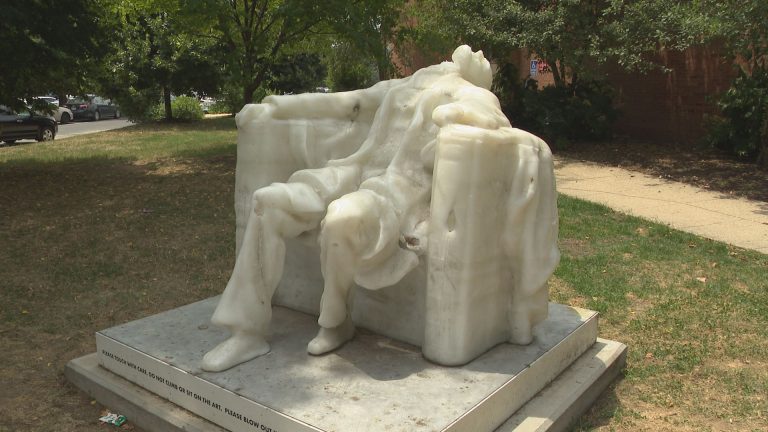As part of the United States As a scorching heat wave gripped the United States over the weekend, sending temperatures to record levels, a six-foot-tall wax statue of Abraham Lincoln went viral for its demise, sparking humorous quips and memes on social media, some innocent, some outrageous.
Titled “40 Acres: Buck’s Camp” (2024), the wax sculpture consists of 10 candle wicks that visitors are encouraged to light and then extinguish after one to two minutes. The sculpture was installed on February 15 outside Garrison Elementary School in Washington, D.C., on the site of Buck’s Camp, a Civil War-era contraband camp where freed formerly enslaved people built a community.

Created by Richmond artist Sandy Williams IV, an assistant professor of art at the University of Richmond, the 3,000-pound wax replica of the Lincoln Memorial was created using a 3D scan of the monument in Washington, D.C. The sculpture, commissioned and presented by the arts nonprofit CulturalDC, is one of a series of wax monuments Williams has been working on since 2017. It is also part of 40 ACRES ArchivesFounded by the artist in 2021, it is an expanding collection of artworks, events, performances, films, and installations focused on African American history.
“The location for 40 Acres: Buck’s Camp was chosen because it sits atop a Civil War-era freedmen’s community that Lincoln frequently passed through and visited while traveling between the White House and the White House. [his] Cabin,” Williams told AllergicHe added that the work aims to “expand awareness of the history of self-liberated black communities during the Civil War and Reconstruction” and “as a way to understand and make sense of our contemporary condition.”
Although Williams explained that the sculpture was supposed to be “impermanent,” extreme temperatures over the past week caused the wax figure to melt faster than expected, resulting in some rather humorous changes — including an unintentional decapitation and Lincoln’s legs being severed — which naturally caught the attention of social media users.
Yesterday, CulturalDC announced that staff had completely removed the president’s head to prevent further damage.
Williams noted that while melting is a fundamental component of the sculptures in this series, they “did not expect this version of the work to melt in this way,” attributing the sudden liquefaction entirely to the heat wave.
“I’ve been using this wax in public sculptures since 2020, but this is the first time that ambient heat has had such a noticeable effect on its integrity,” Williams said, adding that visitors can infer other meanings from the melting that is occurring.
“not only [the current melting] Williams commented: “How a history of ongoing displacement, genocide, inequality, failures of restoration, and mass resistance to social welfare programs has structured our current political and social climate, but these failures have also led to the current climate disaster that affects us all, including the Lincoln sculpture.”

This isn’t the first time the sculpture has failed to go to plan. An earlier version containing 100 wicks was installed in September 2023, but before the official unveiling, a group of people lit more than half of the wicks, causing the sculpture to collapse prematurely again, and Honest Abel’s head to be chopped off.
A representative from CulturalDC told Allergic After consultation with the school principal and local community members, the installation will be removed before students return for the fall semester on August 26.
“This timeline is only slightly earlier than our original withdrawal date of September 1,” the representative said, adding that private collectors and galleries have made offers to purchase the work, although no final decisions have been made.
“Personally, I think this is a great platform to spark conversation not only about the historical significance of the site and Lincoln, but also about what’s happening in the world as it relates to climate change,” Kristi Maiselman, curator and executive director of CulturalDC, told Allergic.


